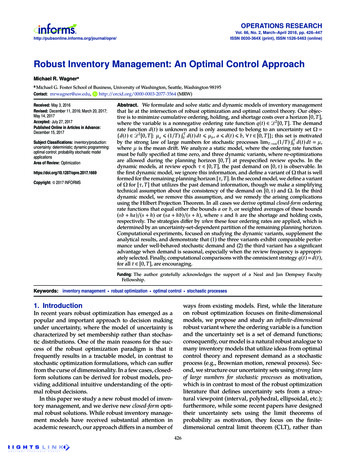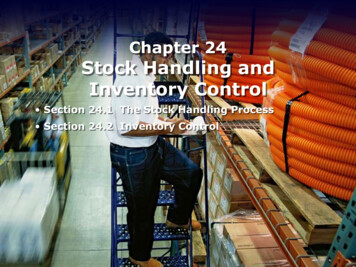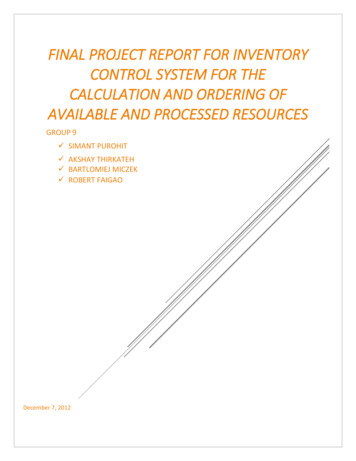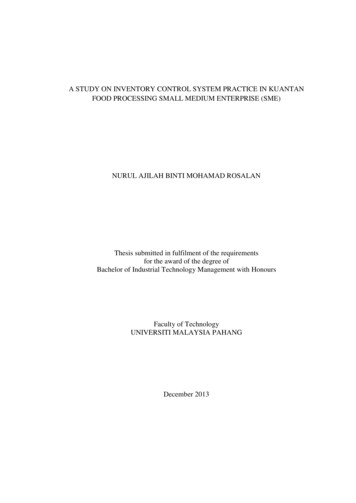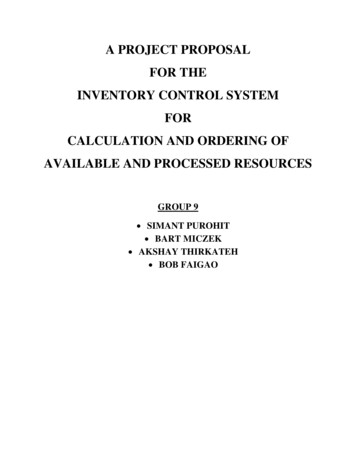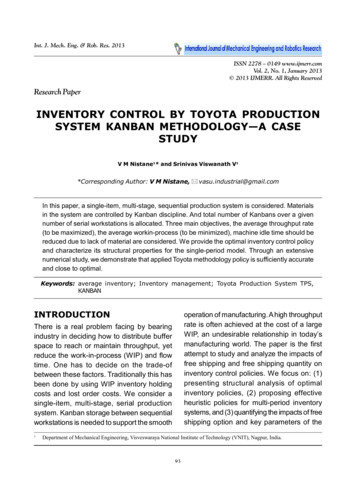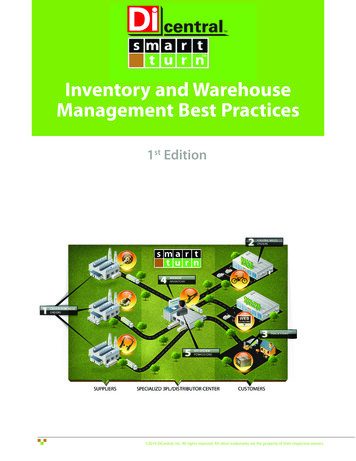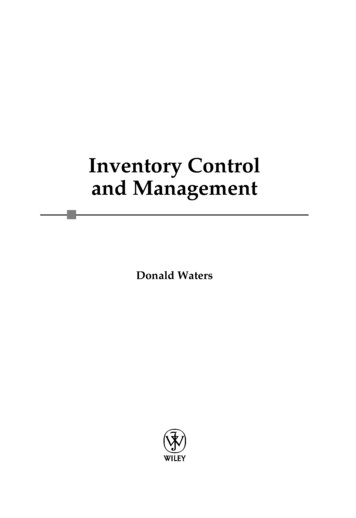
Transcription
Inventory Controland ManagementDonald Waters
Inventory Controland Management
Inventory Controland ManagementDonald Waters
Copyright 2003John Wiley & Sons Ltd, The Atrium, Southern Gate, Chichester,West Sussex PO19 8SQ, EnglandTelephone ( 44) 1243 779777Email (for orders and customer service enquiries): cs-books@wiley.co.ukVisit our Home Page on www.wileyeurope.com or www.wiley.comAll Rights Reserved. No part of this publication may be reproduced, stored in a retrieval system ortransmitted in any form or by any means, electronic, mechanical, photocopying, recording, scanningor otherwise, except under the terms of the Copyright, Designs and Patents Act 1988 or under theterms of a licence issued by the Copyright Licensing Agency Ltd, 90 Tottenham Court Road, LondonW1T 4LP, UK, without the permission in writing of the Publisher. Requests to the Publisher should beaddressed to the Permissions Department, John Wiley& Sons Ltd, The Atrium, Southern Gate, Chichester, West Sussex PO19 8SQ, England, or emailed topermreq@wiley.co.uk, or faxed to ( 44) 1243 770620.This publication is designed to provide accurate and authoritative information in regard to the subjectmatter covered. It is sold on the understanding that the Publisher is not engaged in renderingprofessional services. If professional advice or other expert assistance is required, the services of acompetent professional should be sought.Other Wiley Editorial OfficesJohn Wiley & Sons Inc., 111 River Street, Hoboken, NJ 07030, USAJossey-Bass, 989 Market Street, San Francisco, CA 94103-1741, USAWiley-VCH Verlag GmbH, Boschstr. 12, D-69469 Weinheim, GermanyJohn Wiley & Sons Australia Ltd, 33 Park Road, Milton, Queensland 4064, AustraliaJohn Wiley & Sons (Asia) Pte Ltd, 2 Clementi Loop #02-01, Jin Xing Distripark, Singapore 129809John Wiley & Sons Canada Ltd, 22 Worcester Road, Etobicoke, Ontario, Canada M9W 1L1Wiley also publishes its books in a variety of electronic formats. Some content that appearsin print may not be available in electronic books.Library of Congress Cataloging-in-Publication DataWaters, C. D. J. (C. Donald J.), 1949–Inventory control and management / by Donald Waters. – 2nd ed.p. cm.Includes bibliographical references and index.ISBN 0-470-85876-1 (alk. paper)1. Inventory control. I. Title.TS160.W38 2003658.7 87–dc212003057186British Library Cataloguing in Publication DataA catalogue record for this book is available from the British LibraryISBN 0-470-85876-1Typeset in 10/12pt Palatino by Laserwords Private Limited, Chennai, IndiaPrinted and bound in Great Britain by TJ International, Padstow, CornwallThis book is printed on acid-free paper responsibly manufactured from sustainable forestryin which at least two trees are planted for each one used for paper production.
To Jack
ContentsPreface . . . . . . . . . . . . . . . . . . . . . . . . . . . . . . . . . . . . . . . . . . . . . . . . .xiPART IIntroduction . . . . . . . . . . . . . . . . . . . . . . . . . . . . . . . . . . . . . . . . . . .11 Stocks and Inventories . . . . . . . . . . . . . . . . . . . . . . . . . . . . . . . . . . .3Aims of the chapter . . . . . . . .Stocks of materials . . . . . . . . .Reasons for holding stocks . . .Stocks in the supply chain . . . .Trends affecting stock . . . . . . .Changes to aggregate stocks . .Chapter review . . . . . . . . . . .Project . . . . . . . . . . . . . . . . . .Discussion questions . . . . . . . .References and further reading.337111924282929292 Stocks within an Organization . . . . . . . . . . . . . . . . . . . . . . . . . . . . .31Aims of the chapter . . . . . . . . . . . . . . . .Inventory management and logistics . . . .Setting the aims of inventory managementStrategic role of stock . . . . . . . . . . . . . . .Costs of holding stock . . . . . . . . . . . . . . .Approaches to inventory control . . . . . . .Chapter review . . . . . . . . . . . . . . . . . . .Project . . . . . . . . . . . . . . . . . . . . . . . . . .Discussion questions . . . . . . . . . . . . . . . .References and further reading . . . . . . . .31313644485558596060
viiiContentsPART IIMethods for Independent Demand . . . . . . . . . . . . . . . . . . . . . . . . 633 Economic Order Quantity . . . . . . . . . . . . . . . . . . . . . . . . . . . . . . . .Aims of the chapter . . . . . . . . . . . . .Defining the economic order quantity .Adjusting the economic order quantityUncertainty in demand and costs . . . .Adding a finite lead time . . . . . . . . . .Chapter review . . . . . . . . . . . . . . . .Project . . . . . . . . . . . . . . . . . . . . . . .Problems . . . . . . . . . . . . . . . . . . . . .Discussion questions . . . . . . . . . . . . .References and further reading . . . . .656577868996979798984 Models for Known Demand . . . . . . . . . . . . . . . . . . . . . . . . . . . . . . .99Aims of the chapter . . . . . . . . . . .Price discounts from suppliers . . . .Finite replenishment rate . . . . . . . .Planned shortages with back-ordersLost sales . . . . . . . . . . . . . . . . . . .Constraints on stock . . . . . . . . . . .Discrete, variable demand . . . . . . .Chapter review . . . . . . . . . . . . . .Project . . . . . . . . . . . . . . . . . . . . .Problems . . . . . . . . . . . . . . . . . . .Discussion questions . . . . . . . . . . .References and further reading . . .65.991001131201251281351411421421441445 Models for Uncertain Demand . . . . . . . . . . . . . . . . . . . . . . . . . . . . . 147Aims of the chapter . . . . . . . .Uncertainty in stocks . . . . . . .Models for discrete demand . .Order quantity with shortages .Service level . . . . . . . . . . . . . .Uncertain lead time demand . .Periodic review methods . . . . .Chapter review . . . . . . . . . . .Project . . . . . . . . . . . . . . . . . .Problems . . . . . . . . . . . . . . . .Discussion questions . . . . . . . .References and further reading.147148154166170173181187188188189190
ContentsixPART IIIInformation for Inventory Management . . . . . . . . . . . . . . . . . . . 1936 Sources of Information . . . . . . . . . . . . . . . . . . . . . . . . . . . . . . . . . . 195Aims of the chapter . . . . . . . . . . . . . . . . .Inventory management information systemsInformation from accounting . . . . . . . . . . .Information about supply and demand . . . .Warehousing . . . . . . . . . . . . . . . . . . . . . .Chapter review . . . . . . . . . . . . . . . . . . . .Project . . . . . . . . . . . . . . . . . . . . . . . . . . .Problems . . . . . . . . . . . . . . . . . . . . . . . . .Discussion questions . . . . . . . . . . . . . . . . .References and further reading . . . . . . . . .1951952022112182242252252262277 Forecasting Demand . . . . . . . . . . . . . . . . . . . . . . . . . . . . . . . . . . . . 229Aims of the chapter . . . . . . . .Methods of forecasting . . . . . .Judgemental forecasts . . . . . . .Time series . . . . . . . . . . . . . .Causal forecasting . . . . . . . . .Projective forecasting . . . . . . .Planning forecasts . . . . . . . . .Chapter review . . . . . . . . . . .Project . . . . . . . . . . . . . . . . . .Problems . . . . . . . . . . . . . . . .Discussion questions . . . . . . . .References and further reading.2292302342372412482602622632642652668 Planning and Stocks . . . . . . . . . . . . . . . . . . . . . . . . . . . . . . . . . . . . 267Aims of the chapter . . . . . . . .Levels of planning . . . . . . . . .Aggregate planning . . . . . . . .Master schedules . . . . . . . . . .Operational schedules . . . . . . .Simulation of stocks . . . . . . . .Chapter review . . . . . . . . . . .Project . . . . . . . . . . . . . . . . . .Problems . . . . . . . . . . . . . . . .Discussion questions . . . . . . . .References and further reading.267268274285288292299299300302302
xContentsPART IVMethods for Dependent Demand . . . . . . . . . . . . . . . . . . . . . . . . . 3059 Material Requirements Planning . . . . . . . . . . . . . . . . . . . . . . . . . . . 307Aims of the chapter . . . . . . . . . . . . . . . . . .Limitations of independent demand methodsApproach of material requirements planningBenefits and problems with MRP . . . . . . . . .Adjusting the MRP schedules . . . . . . . . . . .Extensions to MRP . . . . . . . . . . . . . . . . . . .Chapter review . . . . . . . . . . . . . . . . . . . . .Project . . . . . . . . . . . . . . . . . . . . . . . . . . . .Problems . . . . . . . . . . . . . . . . . . . . . . . . . .Discussion questions . . . . . . . . . . . . . . . . . .References and further reading . . . . . . . . . .30730731032132733233633733733933910 Just-in-Time . . . . . . . . . . . . . . . . . . . . . . . . . . . . . . . . . . . . . . . . . . 341Aims of the chapter . . . . . . . . . . . . . . . . . . . . . . . . . . . . .Principles of just-in-time . . . . . . . . . . . . . . . . . . . . . . . . . .Main features for stocks . . . . . . . . . . . . . . . . . . . . . . . . . .Achieving just-in-time operations . . . . . . . . . . . . . . . . . . . .Other effects of JIT . . . . . . . . . . . . . . . . . . . . . . . . . . . . . .Benefits and disadvantages of JIT . . . . . . . . . . . . . . . . . . . .Extending JIT along the supply chain . . . . . . . . . . . . . . . . .Comparisons with other methods of inventory management .Chapter review . . . . . . . . . . . . . . . . . . . . . . . . . . . . . . . .Project . . . . . . . . . . . . . . . . . . . . . . . . . . . . . . . . . . . . . . .Problems . . . . . . . . . . . . . . . . . . . . . . . . . . . . . . . . . . . . .Discussion questions . . . . . . . . . . . . . . . . . . . . . . . . . . . . .References and further reading . . . . . . . . . . . . . . . . . . . . .341341345348354363365367370371371372373Index . . . . . . . . . . . . . . . . . . . . . . . . . . . . . . . . . . . . . . . . . . . . . . . . . . 385
PrefaceThe subjectThis is a book about inventory management. It describes recent thinking aboutstock and methods for its control.You might imagine stock as warehouses full of goods but every organizationholds stock, even those providing the most intangible service. A small company ofknowledge workers, for example, stores information and experience, and it facesthe same problems of inventory management as a giant manufacturer with itsstores of finished goods and components.As stocks are almost universal, we should start with the basic question, ‘Whydo organizations hold stocks?’ The main answer is to allow for variations anduncertainty in supply and demand – they give a buffer between suppliers and customers, maintaining customer service even when there are problems in the supplychain. Unfortunately, this safeguard comes at a high price, and organizations arecontinually looking for ways of reducing their inventory costs without affectingservice. In recent years this search has led to many changes. ‘Scientific inventorycontrol’ is still at the core of inventory management, but it has been enhancedby requirements planning and just-in-time, with e-commerce giving a fast andefficient flow of material through an integrated supply chain.Stock does not exist in isolation, so we have to consider its impact on otherparts of the organization. There are no clear lines between inventory managementand, say, procurement, supply chain management, warehousing, or broaderoperations. So we have to set inventory management in its overall context,noting its interactions with other activities, and explicitly recognizing
solutions to problems, spreadsheets, comments on discussion questions, etc. Overview of the book. The book follows a logical path through inventory management. To make this easier we have divided the material into four parts. Part I gives an overall introduction to inventory management. It discusses the movement of materialsFile Size: 1MBPage Count: 407

